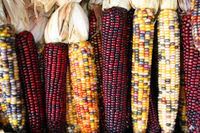Researchers attach genes to minichromosomes in maize - may yield drought and disease resistant crops, better biofuels
 A team of scientists at the University of Missouri-Columbia has discovered a way to create engineered minichromosomes in maize and attach genes to those minichromosomes. This discovery opens new possibilities for the development of crops that are multiply resistant to viruses, insects, fungi, bacteria and herbicides, for the development of proteins and metabolites that can be used to treat human illnesses, and for third generation biofuels (made from energy crops engineered in such a way that their properties are matched to the specificities of a given bioconversion process). The technique used to create engineered minichromosomes should be transferable to other plant species.
A team of scientists at the University of Missouri-Columbia has discovered a way to create engineered minichromosomes in maize and attach genes to those minichromosomes. This discovery opens new possibilities for the development of crops that are multiply resistant to viruses, insects, fungi, bacteria and herbicides, for the development of proteins and metabolites that can be used to treat human illnesses, and for third generation biofuels (made from energy crops engineered in such a way that their properties are matched to the specificities of a given bioconversion process). The technique used to create engineered minichromosomes should be transferable to other plant species.In a paper published in the early edition of the Proceedings of the National Academy of Sciences (PNAS), Weichang Yu, Fangpu Han, Zhi Gao, Juan M. Vega and James A. Birchler built on a previous MU discovery about the creation of minichromosomes to demonstrate that genes could be stacked on the minichromosomes.
“This has been sought for a long time in the plant world, and it should open many new avenues. If we can do this in plants, many advances could be done in agriculture that would not otherwise be possible, from improved crops to inexpensive pharmaceutical production to other applications in biotechnology.” - James A. Birchler, professor of biological sciences in the MU College of Arts and Science.A minichromosome is an extremely small version of a chromosome, the threadlike linear strand of DNA and associated proteins that carry genes and functions in the transmission of hereditary information. Whereas a chromosome is made of both centromeres and telomeres with much intervening DNA, a minichromosome contains only centromeres and telomeres, the end section of a chromosome, with little else. However, minichromosomes have the ability to accept the addition of new genes in subsequent experiments.
Birchler said there have been unsuccessful efforts to create artificial chromosomes in plants but this is the first time engineered minichromosomes have been made:
 bioenergy :: biofuels :: energy :: sustainability :: ethanol :: biodiesel :: biomass :: genetics :: biotechnology ::
bioenergy :: biofuels :: energy :: sustainability :: ethanol :: biodiesel :: biomass :: genetics :: biotechnology :: Minichromosomes are able to function in many of the same ways as chromosomes but allow for genes to be stacked on them. Although other forms of genetic modification in plants are currently utilized, the new minichromosomes are particularly useful because they allow scientists to add numerous genes onto one minichromosome and manipulate those genes easily because they are all in one place, Birchler said. Genetic modification with traditional methods is more complicated because scientists have little control over where the genes are located in the chromosomes and cannot stack multiple genes on a separate chromosome independent of the others.
Resilient crops
By stacking genes on minichromosomes, scientists could create crops that have multiple beneficial traits, such as resistance to drought, certain viruses and insects, or other stresses. In addition, minichromosomes could be used for the inexpensive production of multiple foreign proteins and metabolites useful for medical purposes. Because of their protein-rich composition, a part of the maize kernels (called an endosperm) can be used to grow animal proteins and human antibodies that treat diseases and disease symptoms. Minichromosomes could enable new and better production of these foreign proteins and antibodies. In addition, scientists also may be able to use them to develop plants better suited for biofuel production.
“The technique used to create our engineered minichromosomes should be transferable to other plant species,” Birchler said.
He said he hopes that he and other scientists can use the technique to create minichromosomes in other plant varieties and produce more resistant plant strains, develop more medically useful proteins and metabolites, and study how chromosomes function.
More information:
Weichang Yu, Fangpu Han, Zhi Gao, Juan M. Vega *, and James A. Birchler, "Construction and behavior of engineered minichromosomes in maize" [*abstract], Proc. Natl. Acad. Sci. May 14, 2007, 10.1073/pnas.0700932104
Eurekalert: Researchers attach genes to minichromosomes in maize - May 14, 2007.
 --------------
--------------
 Scania will introduce an ethanol-fueled hybrid bus concept at the UITP public transport congress in Helsinki 21-24 May 2007. The full-size low-floor city bus is designed to cut fossil CO2 emissions by up to 90% when running on the ethanol blend and reduce fuel consumption by at least 25%.
Scania will introduce an ethanol-fueled hybrid bus concept at the UITP public transport congress in Helsinki 21-24 May 2007. The full-size low-floor city bus is designed to cut fossil CO2 emissions by up to 90% when running on the ethanol blend and reduce fuel consumption by at least 25%.








0 Comments:
Post a Comment
Links to this post:
Create a Link
<< Home